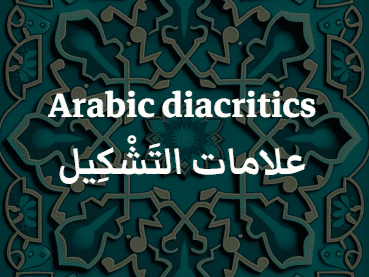Arabic diacritics / عَلامات التَشْكِيل

The Arabic diacritics are broken down into two categories in the Arabic script: consonant pointing (iʻjām/إِعْجام) and supplementary diacritics (tashkīl/تَشْكِيل). Consonant pointing allows us to differentiate between letters, while tashkīl provides phonetic information about how a word should be pronounced. There are six types of tashkīl in Arabic:
Fatḥa

The fatḥa ⟨فَتْحَة⟩ is a small diagonal line placed above a letter and represents a short /a/ (like the /a/ sound in the English word “cat”). Example letter dāl ⟨د⟩ which represents the consonant “d” makes the sound /da/ written ⟨دَ⟩ (with the fatḥa).
In comparison, the letter alif represents a longer /ā/ sound.
The word fatḥah itself means opening and refers to the opening of the mouth when producing an /a/.
Example: فَتَحَ /fataḥa/ → he opened
Ḍamma

The ḍamma ⟨ضَمَّة⟩ is a small curl-like diacritic placed above a letter to represent a short /u/ and its allophones [u, ʊ, o, o̞, ɔ] (as in “put”, or “bull”). Example letter dāl ⟨د⟩ which represents the consonant “d” makes the sound /do/ written ⟨دُ⟩ (with the ḍamma).
It is a smaller replica of the letter و /waw/, while the later represents a longer pronunciation of the ū/ sound.
One of the many meanings of ḍamma is to piece together or stick together, which is the movement we do with our lips when pronouncing sound u/.
Example: مُدُن /mudun/ → cities
Kasra

The kasra ⟨كَسْرَة⟩ is a diagonal line similar to the fatḥa but written below the letter used to designate a short /i/ sound (as in “me”, “be”) and its allophones [i, ɪ, e, e̞, ɛ] (as in “Tim”, “sit”). For example letter dāl ⟨د⟩ which represents the consonant “d” makes the sound /di/ written ⟨دِ⟩ with the kasra.
In comparison, the letter yā’ represents a longer /ī/ sound.
The word kasra refers to something being broken. It conveys the idea that it takes down a word, or almost breaks it.
Example: سِجْن /sijn/ → prison
Note: the ḥarakāt, or ‘motions’, are the diacritical marks that represent short vowels. As mentioned before, Arabic has three main vowel sounds represented by different letters, and thus there are three corresponding ḥarakāt: fatḥa (for /a/), ḍamma (for /u/) and kasra (for /i/).
Madda

The madda ⟨مَدّة⟩is a tilde-shaped diacritic which, in Arabic, can only appear on top of an alif and indicates a glottal stop followed by a long /aː/. The same sequence /ʔaː/ could also be represented by two alifs. However, consecutive alifs are never used in Arabic orthography. Instead, this sequence must always be written as a single alif with the maddah above it – this combination is known as an alif maddah.
Example: قُرْآن /qurˈʔaːn/ → Qur’an
Sukūn

The sukūn ⟨سُكُونْ⟩ is a diacritic in the shape of a circle, placed above a letter ( ْ). It signifies that the consonant it is attached to does not have a vowel following it, i.e., there is no vowel sound. This symbol is essential for writing consonant-vowel-consonant syllables, which are quite common in Arabic.
Example: دَدْ /dad/
Shadda

The shadda ⟨شَدّة⟩ is a diacritic symbol that geminate, or double consonants which are phonemic in Arabic. It written above the letters to be doubled, and it is -the only ḥarakah- used commonly in spelling to avert ambiguity.
Example: دّ /dd/; madrasa ⟨مَدْرَسَة⟩ (school) vs. mudarrisah ⟨مُدَرِّسَة⟩ (teacher, female)
Tanwīn

The tanwīn ⟨تَنْوِين⟩ represents the consonant /n/ that follows the three vowel diacritics (fatḥa, ḍamma and kasra) when doubled at the end of a word. The signs from right to left respectively denote -un, -in, and -an. These endings are generally used whenever a word is indefinite in Arabic.
The tanwīn fatha is typically written in unvocalized texts because the letter alif should always be written along with (except for words ending in tā’ marbūṭa, hamza or diptotes).
Here are the grammatical cases and tanwīn endings in indefinite triptote forms:
-un: nominative case.
-an: accusative case (also functions as an adverbial marker).
-in: genitive case.
Waṣla

The waṣla ⟨وَصْلة⟩ (meaning ’an instance of connection’) or hamzatu l-waṣli ⟨هَمْزةُ الوَصْل⟩ is an Arabic diacritic sometimes placed over the letter ʾalif at the beginning of the word. It indicates that the alif is not pronounced as a glottal stop (written with the letter or diacritic hamza ء), but that the word is connected to the previous word (like liaison in French). Outside of vocalised liturgical texts, the waṣla is usually not written.

Responses